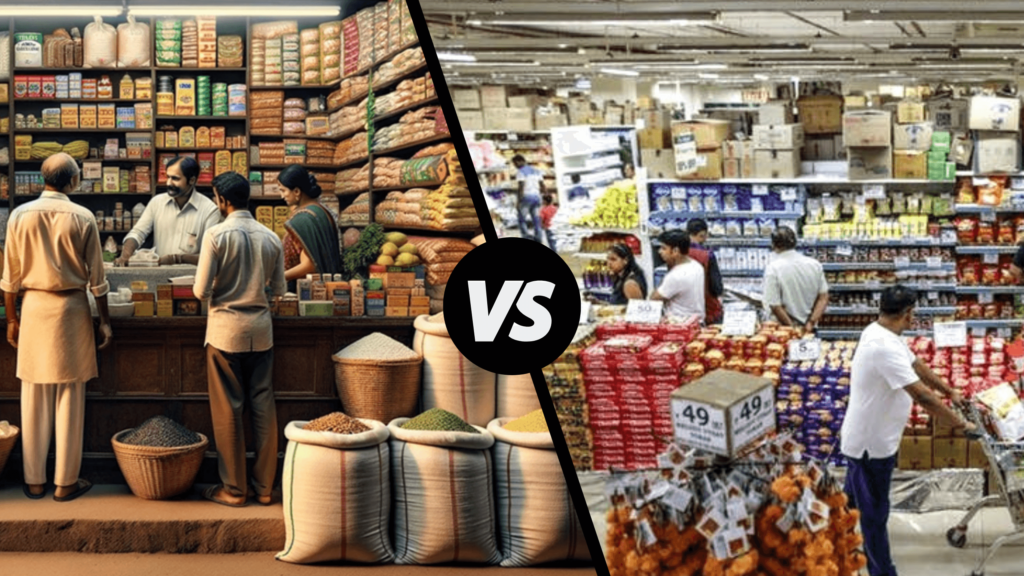
Owning a Kirana store, a traditional small grocery store in India, is more than just stocking shelves and opening the doors to customers. It’s about understanding the local market, catering to the needs of the community, and constantly adapting to changes. Let’s explore seven key strategies that can help in successfully planning and running a Kirana store.
1. Understand Your Customers
In the world of retail, especially in a Kirana store, knowing who your customers are is incredibly important. You need to understand their needs and preferences to serve them better. Let’s break down what this really means.
Demographics: Who Are Your Customers?
-
Families: They might buy groceries in larger quantities, like big packs of rice or oil.
-
Young Professionals: They often look for quick, easy-to-cook meals or snacks.
-
Elderly People: They may prefer smaller packets and items that are easy to use.
Buying Preferences: What and When Do They Buy?
-
Frequent Purchases: Some items, like bread or milk, are bought often. Keeping these in stock is crucial.
-
Shopping Times: Do people shop more in the mornings or evenings? On weekends or weekdays? This helps in planning your store timings and staff shifts.
Feedback: Listening and Responding Your Customers
-
Ask Customers: Simple questions like “What would you like to see in the store?” can give great insights.
-
Act on Feedback: If many customers ask for a new product, try to get it. If they complain about something, try to fix it.
2. Range and Assortment
When we talk about range and assortment in a Kirana store, it’s about the variety and types of products you offer. Here are some key points in product assortment:
- Wide Range of Products
-
Diverse Selection: Offer a broad range of items to cater to different customer needs. This could include various types of grains, spices, snacks, and personal care items.
-
Essentials and Extras: Make sure to stock essential daily items, but also include some unique or special products that might not be available everywhere.
Assortment Depth
-
Variety Within Categories: Within each product category, try to have a variety of options. For example, in the tea section, offer different brands and types like green tea, black tea, and herbal tea.
-
Different Price Points: Include products at various price levels to cater to customers with different budgets.
Regularly Update Inventory
-
Seasonal Products: Stock seasonal items like specific snacks during festivals or cold remedies in winter.
-
New Products: Keep an eye out for new and trending items to keep your store’s offerings fresh and exciting.
Customer Preferences
-
Local Tastes and Needs: Understand the preferences of your local community. For example, if you’re in an area with many health-conscious people, stock more organic and healthy options.
-
Feedback-Driven Assortment: Actively seek and incorporate customer feedback into your product selection.
Competitive Differentiation
-
Unique Offerings: Have some products that set your store apart from others, giving customers a reason to choose your store over competitors.
-
Quality Assurance: Ensure the products you offer are of good quality, building trust and loyalty with your customers.
3. Effective Inventory Management
In a Kirana store, how you handle your inventory – that is, all the items you sell – is really important. Let’s simplify how you can manage your store’s inventory effectively.
Tracking Inventory: Keeping an Eye on What You Have
-
What’s In Stock: Know what items you have and how many. This helps in not buying more of what you already have enough of.
-
What’s Running Low: Notice which items are almost gone. This is like knowing you’re almost out of milk and need to buy more soon.
-
What’s Not Selling: Sometimes, you might have items that no one is buying. It’s like having a jar of pickles in the fridge that no one eats.
Optimising Stock Levels: Ordering Just Right
-
Use Software or a Manual System: You can use a computer program or even a simple notebook to keep track of your stock and know when to order more.
-
Order Efficiently: This is about timing your orders so you get new stock just as the old one is about to run out. Not too early, and not too late.
-
It’s like buying groceries for the week – enough to last you but not so much that it goes bad.
Reducing Waste: Keep Things Fresh
-
Monitor Expiry Dates: Keep an eye on when things are going to expire. It’s like checking the expiration date on a carton of milk.
-
Move Older Stock to the Front: Put the items that will expire soon at the front, so they get sold first which is called First In First Out (FIFO) method. It’s like using the older vegetables in your fridge first before they go bad.
4. Strategic Product Placement
Arranging your store is a lot like setting up a fun game for your customers, guiding them through and making sure they find (and buy) more than they planned. Let’s look at how to do this in a simple way.
High-Demand Items at the Back
-
Why at the Back?: It’s a clever trick. By placing these items at the far end of the store, customers have to walk through different aisles to reach them. On their way, they might see something else they need or something that catches their eye. It’s a bit like when you go into a candy store for just one thing but end up looking at everything else too.
Impulse Buys Near the Checkout
-
Place Them Near the Checkout: Small, inexpensive items like candy, gum, or keychains are perfect for this. When customers are waiting in line to pay, they’re more likely to add these to their purchase. It’s kind of like when you’re waiting to check out online and see those last-minute deal items.
Visibility: Easy to See and Reach
-
Products Should Be Easy to Spot: Arrange items so they’re at eye level or in clear view. If something is hidden or hard to see, customers might not even know it’s there.
-
Make Sure Items Are Accessible: Put things where customers can easily reach them. It’s important for everyone, especially for those who might find it hard to bend down or reach high shelves. It’s like making sure all the goodies at a party are on a table where everyone can reach them, not just the tall people!
5. Competitive Pricing Strategy
Setting the right prices in your store is a bit like playing a friendly game where you want to score well without going overboard. You have to be smart about it so that your customers feel they’re getting good value and you’re also making a profit. Let’s break down how you can do this.
Watching Local Competition
-
Why It Matters: If the store down the street is selling the same things but at lower prices, your customers might go there instead.
-
What to Do: Regularly check the prices at other nearby stores. It helps you decide if you need to adjust your prices to stay competitive.
Value Perception: Price vs. Quality
-
Slightly Higher Prices Can Signal Better Quality: Sometimes, if you price your items a little higher, customers might think they’re getting something better than what’s available at the store next door.
-
Be Careful: Just make sure the quality of your products matches the price. If you charge more, customers will expect more.
Discounts and Offers
-
Attract Customers: Sales, discounts, or special offers can bring more people into your store.
-
Sustainability: Make sure you’re not cutting prices so much that you’re not making a decent profit. It’s like having a sale on your lemonade stand but making sure you’re still earning enough to buy more lemons.
6. Leverage Technology
Using technology in your store is like having a smart helper who makes things easier and faster for both you and your customers. Let’s talk about how different types of technology can help your store.
POS Systems: Making Sales Smooth
POS stands for Point of Sale, and a POS system is like a high-tech cash register.
-
Better Transaction Management: It helps you manage sales, process payments, and even print receipts. It’s faster and more accurate than doing it all by hand.
-
Benefits: You can quickly see how much you sold in a day, which items are popular, and it makes checkout faster for your customers.
Inventory Management Software: Keeping Track of Stock
-
Tracking Stock Levels: The software keeps an eye on what’s in stock, what’s running low, and what isn’t selling much.
-
Sales Patterns and Reordering: It can also show you what items sell the most and remind you when it’s time to order more.
Digital Payments: Making Buying Easy
-
More Payment Options: Many customers these days prefer to pay with their phones. It’s quick and easy.
-
Advantages: It makes the payment process faster, and you don’t have to handle as much cash, which can be safer and more convenient.
7. Regularly Review and Adapt
In the fast-paced world of retail, staying the same is not an option if you want to be successful. It’s like being a sailor; you need to constantly adjust your sails as the wind changes. Let’s break down how you can stay on top of things and adapt your business strategy accordingly.
Following Market Trends
-
Stay Updated on New Products: Always look out for new items that are becoming popular. It’s like knowing what the new trend in smartphones is.
-
Keep Track of Consumer Trends: Understand what your customers are beginning to like more. Maybe they are getting more health-conscious or prefer eco-friendly products.
Regular Business Review
-
Review Sales Data: Look at what’s selling well and what’s not. It’s like checking which dishes are popular in a restaurant.
-
Listen to Customer Feedback: What your customers say can give you great insights. It’s like getting advice on how to improve your cooking.
-
Check Operational Efficiency: See if there are any ways you can make running your store smoother and more cost-effective.
Adapting Based on Data
-
Be Ready to Change: If the data shows that a product is not selling, consider replacing it with something else. If customers suggest they would like home delivery, think about offering that service.
-
Flexibility is Key: The ability to quickly change your strategy is a big advantage in the fast-moving retail world.
In conclusion, successfully running a Kirana store involves a mix of understanding your customers, managing your inventory effectively, strategic product placement, competitive pricing, leveraging technology, building a community presence, and being adaptable to change. Implementing these strategies can help ensure your Kirana store is not just a shop, but a valued part of the local community.
If you want to plan your kirana store or supermarket strategy then get in touch with Kirana Friends. You can connect with a Kirana Expert by calling or messaging us on 8010442222.
You can also download the Kirana Friends Application from the Google Play store by clicking on the link below and learn how to run your store more profitably.





